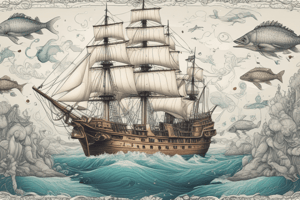Podcast
Questions and Answers
What percentage of the Earth's surface is covered by the ocean?
What percentage of the Earth's surface is covered by the ocean?
- 50%
- 80%
- 60%
- 70% (correct)
What is the main purpose of bioluminescence in ocean creatures?
What is the main purpose of bioluminescence in ocean creatures?
- To regulate the Earth's climate
- To communicate with other species
- To serve various purposes such as attracting mates, deterring predators, and luring prey (correct)
- To produce food through photosynthesis
What is the deepest part of the world's oceans?
What is the deepest part of the world's oceans?
- The Mariana Trench (correct)
- The Red Sea
- The Great Barrier Reef
- The Atlantic Ocean
What process do bacteria use to convert chemicals from hydrothermal vents into energy?
What process do bacteria use to convert chemicals from hydrothermal vents into energy?
What is the ocean's role in regulating the Earth's climate?
What is the ocean's role in regulating the Earth's climate?
What drives the ocean's currents?
What drives the ocean's currents?
What is a significant threat to the ocean's delicate balance?
What is a significant threat to the ocean's delicate balance?
What is a pervasive problem affecting marine life and ecosystems?
What is a pervasive problem affecting marine life and ecosystems?
Which type of tactic focuses on movement and positioning to gain an advantage over the enemy?
Which type of tactic focuses on movement and positioning to gain an advantage over the enemy?
What is the principle of tactics that emphasizes the importance of allocating forces efficiently to achieve maximum effect?
What is the principle of tactics that emphasizes the importance of allocating forces efficiently to achieve maximum effect?
Which tactical formation is used to break through enemy lines?
Which tactical formation is used to break through enemy lines?
What is the primary purpose of reconnaissance in tactical operations?
What is the primary purpose of reconnaissance in tactical operations?
What type of tactic uses sudden and intense attacks to overwhelm the enemy?
What type of tactic uses sudden and intense attacks to overwhelm the enemy?
Which principle of tactics emphasizes the importance of protecting friendly forces from enemy action?
Which principle of tactics emphasizes the importance of protecting friendly forces from enemy action?
Flashcards are hidden until you start studying
Study Notes
The Ocean's Significance
- The ocean covers over 70% of the Earth's surface, yet remains largely unexplored.
Bioluminescent Organisms
- Bioluminescent organisms produce light through chemical reactions within their bodies.
- This phenomenon serves various purposes, including:
- Attracting mates
- Deterring predators
- Luring prey
Geological Features
- The Mariana Trench is the deepest part of the world's oceans, plunging nearly 36,000 feet below sea level.
- Underwater mountains and valleys form a landscape more dramatic than any found on the Earth's surface.
- Hydrothermal vents:
- Spew mineral-rich water at extreme temperatures.
- Support unique ecosystems that thrive without sunlight.
- Teeming with life forms that rely on chemosynthesis.
Ocean's Role in Climate Regulation
- The ocean absorbs and stores large amounts of carbon dioxide, helping to mitigate the effects of climate change.
- Ocean currents:
- Distribute heat around the globe.
- Influence weather patterns and marine ecosystems.
Threats to the Ocean
- Human activities posing a threat to the ocean's health:
- Pollution
- Overfishing
- Climate change
- Plastic waste is a pervasive problem, affecting marine life and ecosystems.
Conservation Efforts
- Marine conservation initiatives aim to protect and preserve the ocean's health.
- Sustainable fishing practices and reducing carbon emissions are essential to safeguarding the ocean.
Tactics
Types of Tactics
- There are four main types of tactics: maneuver, firepower, shock, and deception.
- Maneuver Tactics involve using movement and positioning to gain an advantage over the enemy.
- Firepower Tactics rely on firepower to weaken or destroy the enemy.
- Shock Tactics involve using sudden and intense attacks to overwhelm the enemy.
- Deception Tactics use deception, misdirection, and surprise to gain an advantage.
Principles of Tactics
- There are six principles of tactics: unity of command, economy of force, maneuver, surprise, security, and simplicity.
- Unity of Command: A single commander is responsible for making decisions to avoid confusion and ensure clarity.
- Economy of Force: Allocate forces efficiently to achieve maximum effect while minimizing waste.
- Maneuver: Use movement and positioning to gain an advantage over the enemy.
- Surprise: Use unexpected actions to gain an advantage over the enemy.
- Security: Protect friendly forces from enemy action to prevent unnecessary casualties.
- Simplicity: Use simple and clear plans to achieve objectives and avoid confusion.
Tactical Formations
- There are four main types of tactical formations: line, column, wedge, and ambush.
- Line Formation: Troops are arranged in a line to maximize firepower and present a broad front to the enemy.
- Column Formation: Troops are arranged in a column to facilitate movement and speed.
- Wedge Formation: Troops are arranged in a triangular formation to break through enemy lines.
- Ambush Formation: Troops are hidden to surprise and attack the enemy from a concealed position.
Tactical Operations
- Reconnaissance: Gathering information about the enemy to inform tactical decisions and gain an advantage.
- Patrolling: Small units conducting reconnaissance or security operations to gather information and secure areas.
- Raids: Quick, surprise attacks to achieve a specific objective and then withdraw.
- Ambushes: Hiding troops to surprise and attack the enemy from a concealed position.
- Flanking: Attacking the enemy from the side or rear to gain an advantage and exploit their vulnerabilities.
Studying That Suits You
Use AI to generate personalized quizzes and flashcards to suit your learning preferences.




